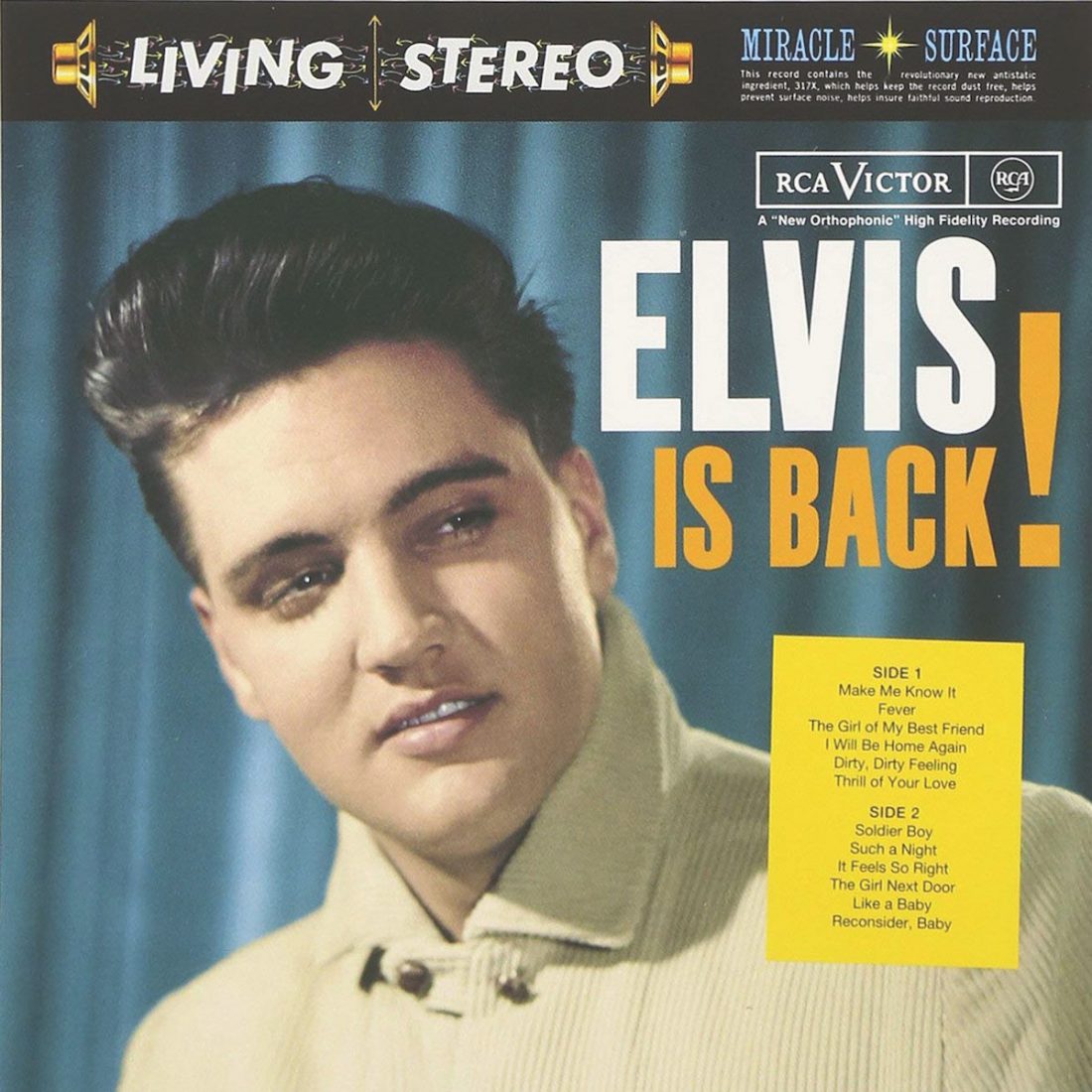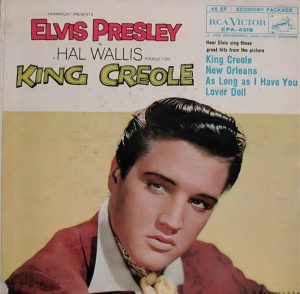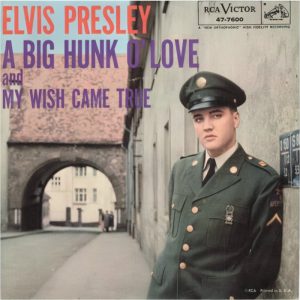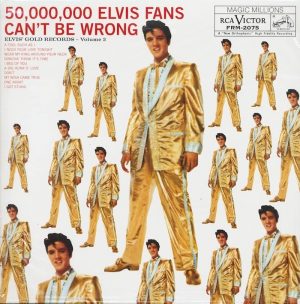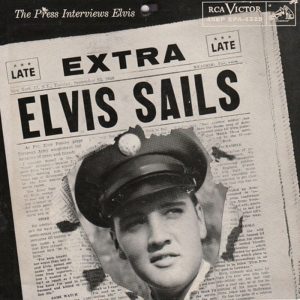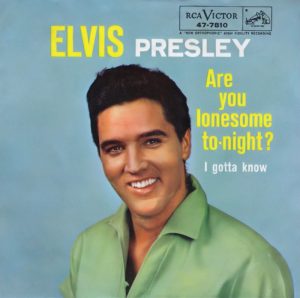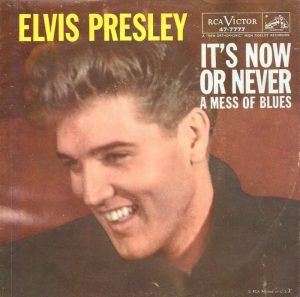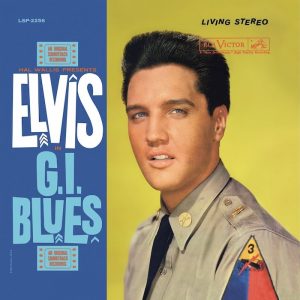After two years in the US Army, an uncertain Elvis Presley faced a significant crossroads in his career when he returned to the music business in 1960. Here, Vintage Rock examines how his fourth studio album, Elvis Is Back! marked a pivotal turning point in the singer’s life. Truly a case of “It’s Now Or Never” for The King…
When a 23-year-old Elvis was transferred to West Germany to join the 1st Medium Tank Battalion in 1958, he had no way of knowing how two years away would impact his life. What kind of man would he become? How much would the music scene evolve in his absence? Would he even have a place in the entertainment industry at all?
On his aptly named LP Elvis Is Back!, Vintage Rock explores how the star addressed these pressing questions and went on to navigate a critical crossroads in his career. We examine how the once-radical rebel returned home from the military as a rebranded all-American hero and delivered a triumphant, yet more refined, album that embraced his influences – both old and new.
Before entering the army, Elvis was considered public enemy number one with the conservative populace. His rebellious rock’n’roll and controversial television appearances had caused widespread outrage. However, a proper stint grafting as a regular GI, rather than opting for a more moderate role in the Special Services, would do his universal image no harm at all and surely tame the wild hillbilly cat.
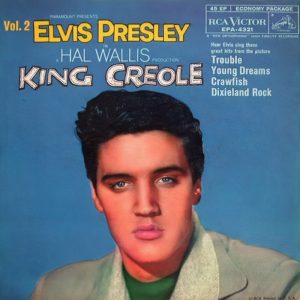 Special Service
Special Service
Rather than being a shrewd business move by his manager, Colonel Tom Parker, Piers Beagley, President and Editor of elvisinfonet.com, believes there was an alternative motive behind the decision. “If Elvis went into the Special Services, then Parker would lose control of his client and his moneymaker,” he tells Vintage Rock.
“The US Army would have Elvis performing in front of soldiers for free and wherever they desired. This would be the last thing Parker would’ve wanted. By putting Presley into the regular service, he could still control the entertainment side of Elvis’ career.”
And the management of Presley’s profession was certainly at the forefront of Parker’s mind. Indeed, perhaps the most perceptive decision he made prior to Elvis’call-up was to have him record a number of songs he could eke out during the two years that Presley was away, thus ensuring heartbroken fans were kept satisfied, that his star’s name would remain prominent and, more importantly, the money would still be rolling in.
Bridging The Gap
Sessions for the King Creole soundtrack, initially put out as an EP album with two volumes, were held at Hollywood’s Radio Recorders in January 1958 and the title track, alongside Hard Headed Woman, surfaced as singles later in the year.
One Night, also cut in L.A. on 23 February 1957, was released on 21 October 1958 and delivered Elvis’ first big chart hit while in the army. The last session, that took place during a two-week furlough in June 1958, was his first at Studio B in Nashville and resulted in further future hits A Big Hunk O’ Love and I Need Your Love Tonight.
“Unfortunately,” explains Beagley, “with little product left in the can, the Colonel starved RCA, leaving them with almost no new Elvis material. This led to the release of several album compilations, which sold in reasonable numbers but did little to push Presley to the top of the charts. In March 1958, the astoundingly good Elvis’ Golden Records only reached Billboard No.3, while in November 1959, Elvis’ Gold Records Vol. 2 made a lowly No.31.”
Soldier Boy
Beagley adds, “The Colonel kept Elvis closely informed about every move he was making and even sent movie producer Hal Wallis to Germany in August 1959 to discuss his upcoming movie G.I. Blues, but he never travelled himself – as we know now, Parker had no passport and was an illegal US alien.
“Not allowing Elvis to record anything professionally while in Germany was a missed opportunity. We know that Parker sent Elvis suggestions of future material, but as the Memphis Recording Service release of Elvis: Made In Germany (The Complete Private Recordings) proves, Presley was listening to a lot of music and happily recording new ideas onto a home tape recorder.
“Had Elvis been allowed to professionally track some new material, which later could have been overdubbed or left raw, there is little doubt that RCA could have put out a chart-topping album. After all, the desperate old carny had the label release the big-selling EP, Elvis Sails, consisting only of 10 minutes of press interviews. Surely some army home recordings were an obvious possibility?”
Never Forget
Despite being kept updated and having Colonel Parker handle affairs while he was away, Elvis still harboured deep concerns about his career. In an interview aboard the USS Randall, minutes before departing for Germany on 22 September 1958, Pat Hernon asked if he had any messages for his fans. “I’m going to be out of their eyes for some time,” an earnest Elvis replied. “I hope that I’m not out of their minds. I’ll be looking forward to the time when I come back and entertain again like I did.”
“He was worried,” reasoned DJ Fontana in The Seven Ages Of Elvis. “Would he come back and be the same guy or the same artist that he was before.”
It’s a belief that is confirmed by Priscilla Presley in Netflix documentary The Fall And Rise Of Elvis: “He was very nervous about whether or not he would still be in the business or even sing again. He was away for quite a while, and he thought a lot of his fans would forget him.”
Changing Times
“Elvis knew that the music field was changing, the original excitement of rock’n’roll was fading in the charts,” observes Beagley. “When Elvis got his draft notice in Christmas 1957 his career as a major entertainer had been going for less than two years and so Presley was extremely worried that two years of military service might destroy everything that he had achieved.
“Lamar Fike, Presley’s friend in Germany noted that ‘he was scared to death his career was going to dry up’. There were plenty of reasons for Elvis to wonder whether his career as a major star would survive. In the two years that he was in the army, the foundations of rock’n’roll collapsed: Jerry Lee Lewis’ career was derailed by the scandal of his marriage to 13-year-old first-cousin-once-removed Myra Gail Brown in May 1958; Chuck Berry was arrested and later served prison time for taking a 14-year-old Janice Escalante across state lines in December 1959; and on 3 February 1959 Buddy Holly, Ritchie Valens and ‘The Big Bopper’ J. P. Richardson were all killed in a plane crash.”
Just as the rise of rock’n’roll had caused a seismic shift in the music landscape between 1954 and 1959, nothing gold can stay. By the end of his tenure in Germany, Presley had reached a pivotal point in his musical journey.
Back In Business
Touching down at McGuire Air Force Base in New Jersey on 3 March 1960, a smiling Elvis dressed in military finery, attended a press conference at Fort Dix where an interviewer asked if “two years of sobering army life” had changed his mind on rock’n’roll. “Sobering army life,” Elvis responded with a knowing smile. “No, it hasn’t. It hasn’t changed my mind because I was in tanks for a long time you see, and they rock’n’roll quite a bit”.
Ever the charmer, he may have been joking, but those two years in Germany no doubt helped inform Elvis Is Back!
“Elvis was always listening to Armed Forces Radio to keep up with the US charts and would make sure friends would send him new 45s to listen to,” reveals Beagley. “Historians always talk about Elvis’ vast knowledge of every musical genre and his army home recordings certainly prove that point.”
Brothers In Arms
“Presley befriended Charlie Hodge,” continues Beagley, “a singer in the Foggy River Boys country gospel quartet, on the ship travelling over to Germany. So, Hodge and Elvis would sing gospel songs together and also discussed their Southern influences.
“Even while working as a regular soldier Elvis was still bursting with music. While the home tapes we have heard only capture a couple of hours of Elvis jamming,they contain a large number of tracks that he’d later record professionally for RCA. These included His Hand In Mine, Like A Baby, I’ll Take You Home Again Kathleen, I Will Be True, Danny Boy, The Fool, even an attempt at Are You Lonesome Tonight and There’s No Tomorrow – later reinvented as It’s Now Or Never.
“Elvis would sing favourites such as Nat King Cole’s Mona Lisa, Hank Williams’ I Can’t Help It as well as Dean Martin’s Italiano-style Return To Me, which would have been charting at the time. Once back in the States, Elvis would, of course, record several Italian-influenced songs, taking them to the top of the charts.”
An Evolving Landscape
Back in Memphis, at another press conference held on 7 March 1960, one journalist asked Elvis about his return to music and entertainment. “That was the hardest part of it all – being away from showbusiness,” he responded sagely. “It wasn’t the army, it wasn’t the other men, it was that… it stayed on my mind. I kept thinking about the past all the time… contemplating the future.”
When pressed on whether he thought music had changed since his time in the service, he answered, “Possibly yes, I can’t say really, I haven’t been here long enough to even know. The only thing I can say is that if it has changed, well, I’d be foolish not to try and change with it…”
Rock’n’roll was evolving and moving with the times. Presley himself had matured, as had his fans.
“I think it’s very important to keep in mind that here was a poor boy who grew up in Mississippi who had suddenly found himself the most popular recording star in the world,” notes Paul Kingsbury, Senior Director of Editorial at the Country Music Hall Of Fame. “Initially, he had followed his instincts and that of Sam Phillips, to play rockabilly. But it is very clear he had ambitions to become a star like Dean Martin or Frank Sinatra and appeal to a wide range of people. He certainly had the sort of voice that could do so. I think it’s interesting that in between the two sessions for Elvis Is Back! he did the Sinatra TV special and that he was trying to fit in to that wider realm of pop music.”
A Frank Exchange
Two days after he was officially discharged from active duty, Elvis was immediately asked about his future plans. “Well, the first thing I have to do is cut some records,” a weary Presley replied, “and then I have a television show with Frank Sinatra…”
Colonel Tom’s objective was to strike while the returning Sergeant was still hot news. Having secured an exclusive deal with ABC for Presley’s first TV appearance in three years, a performance with Ol’ Blue Eyes would no doubt announce that his star was back and shining brighter than ever. Immediately after recording Stuck On You and Fame And Fortune on 21 March, Elvis and his entourage headed for Miami to film The Frank Sinatra Timex Special: Welcome Home Elvis where he’d perform these new songs.
“It was all about ratings and publicity,” Piers Beagley tells Vintage Rock. “Even though Frank had previously made derogatory comments about his music, Elvis was smart enough to realise that the show would work to his advantage. Plus, the money was unprecedented – Presley was paid more for his eight minutes than Sinatra was for the whole show.”
The lucrative move paid off, as Bruce Springsteen astutely observed in The Searcher: “Elvis put himself forth as somebody who was not a flash in the pan… There was a life for Elvis after Elvis.” Presley was now part of the gang and well and truly back.
Special Comeback
In 2018’s The Searcher documentary Priscilla Presley states: “[Elvis] didn’t want to do the same music, he wanted to grow. He wanted to evolve in a way that he could offer something different in his music… He knew that the next album was important, he gave it a lot of thought… These were his song choices.”
It is a sentiment echoed by Beagley: “Elvis Is Back! was the first true Presley album that wasn’t compromised by external pressures.”
“In an amazing two night’s work,” continues Beagley, “Elvis recorded 18 classic tracks including seven Gold records. RCA and Elvis had plenty of material to choose from to create his ‘comeback’ album. While the overall sound had a smoother feel, nothing stopped Elvis putting his passion for the blues into the recordings of Jesse Stone’s Like A Baby, the pleading It Feels So Right or the magnificent Reconsider Baby by Lowell Fulson – a song that Elvis would have known since its 1954 release. All three of these would have fitted perfectly into Elvis’ pre-army albums.
“Peggy Lee’s Fever, a Top 10 Billboard hit in 1958, would have been playing on Armed Forces Radio, and it was her sultry, sexy, style that Elvis copied. He was so at ease with the song that it was completed in four easy takes.
“With help from friend Charlie Hodge, he had developed a richer vocal technique while in the army, which he had tried out on various gospel numbers and also on Italian operatic-style songs. Presley had never hidden his love of Mario Lanza and a rewrite of O Sole Mio, It’s Now Or Never, was an inspired suggestion.”
The A-Team
For his previous Nashville session in June 1958, producer Chet Atkins had assembled the Nashville ‘A-Team’, a group of talented session musicians that truly understood one another. Guitarist Hank Garland, bassist Bob Moore, pianist Floyd Cramer and drummer Buddy Harman were a tight unit who could complement Elvis’ fuller vocal range with ease. It was no surprise that these same musicians would reassemble for Presley’s first post-army RCA session.
“Initially, the A-Team played on country sessions,” Kingsbury informs Vintage Rock, “but as Nashville became more of a mecca for pop and rock artists to record throughout the 1950s, they utilised their skills and expanded their repertoire. Aided by his long-standing bandmates DJ Fontana and Scotty Moore, and the vocal quartet that he loved, The Jordanaires, Elvis immediately felt very comfortable. If Colonel Parker and Steve Sholes, who was in charge of RCA’s recordings, thought that these were the guys to play with, then Presley was fine with it.
“When Elvis arrived at the studio, he hung out with everybody, played some gospel songs and goofed around with Bob Moore. The engineer on Elvis’ back sessions, the great Bill Porter, said that to his memory, Elvis and Bob were doing karate moves for about 45 minutes until everybody got tired of it. But Chet and Steve both let Presley run the session the way he wanted to.”
Your Sax Is On Fire
A notable introduction was A-Teamer Boots Randolph on the saxophone. “He stands out on a couple of tracks, such as Reconsider Baby, Such A Night and Like A Baby, but I wouldn’t say he is pervasive throughout,” says Kingsbury of the record. “However, he did add a new flavour to Elvis’ recording, which I think was really welcomed.”
“Reconsider Baby, recorded in one magnificent live take, captures Elvis at his best,” adds Beagley. “He is consumed in the passion of the music. In a moment of profound spontaneity, the wailing sax of Boots combined perfectly with Elvis’ intense vocal, and it really is hard to beat.
“In my opinion, the original 12-track album was Elvis’ best to date and featured a wonderful range of styles. It also highlighted his richer vocal. Presley is obviously totally at ease, whether he is singing the sublime, harmony-laden, doo-wop of Thrill Of Your Love, the cool pop of Otis Blackwell’s Make Me Know It, the sultry jazz of Fever, the steamy blues of Like A Baby and Reconsider Baby, or just the plain down-and-dirty rock’n’roll of Such A Night. Elvis seems totally at home and unstoppable.
Now Or Never
“The key reason for the first session on 20 March 1960 was to lay down a brand new chart-topping single. Stuck On You, chosen for its smooth Don’t Be Cruel and All Shook Up feel, had already been selected as the A-side with the beautiful ballad Fame And Fortune on the flip. It was probably a mistake by the Colonel not to include these songs on the album. Other LPs at the time would feature lead singles and this would have guaranteed a bigger-selling, more mainstream, release.
“Other songs recorded during the sessions included It’s Now Or Never and Are You Lonesome Tonight?. Being greedy, Parker decided to keep these singles off the album, too, enabling him to keep releasing Elvis Gold Album collections and, as a result, earn even more loot later on. However, had they been included on Elvis Is Back! it would’ve boosted the LP’s popularity at the time and made it a ‘classic Elvis album’. His idea quickly seemed outdated as the 1960s progressed.”
It’s Now Or Never would ultimately be Presley’s biggest international single and topped the UK chart for eight weeks at the tail end of 1960. “When they recorded It’s Now Or Never, Floyd Cramer made the suggestion that the song would benefit from castanets,” reveals Kingsbury. “So, they recorded an overdub session after with Floyd playing those castanets.”
One And Done
Similarly, follow-up 45, Are You Lonesome Tonight?, a favourite song of Parker’s wife, held the No.1 spot in the British hit parade for four weeks in February 1961. Kingsbury said: “On Are You Lonesome Tonight?, Elvis requested that they turn off all the lights and it be dark in the studio, with just an acoustic guitar, string bass, and The Jordanaires.
“However, when he got to the end, The Jordanaires hit the wrong note for their final ‘oohs’. They all heard it in the studio and the engineer, Bill Porter, wanted to do another complete take. Steve Sholes was up for it but Elvis, who didn’t care for the song that much, felt like he’d done it and told Bill Porter to throw it away. Knowing it was a hit, Sholes had The Jordanaires go back and re-record their ending again without Elvis and just spliced it in on the end. However, Elvis’ vocal was all one take, which really shows just how good a singer he was.
“Interestingly, having sang Are You Lonesome Tonight? in a darkened studio, Elvis later requested that they installed coloured lighting so that he could get the mood just right. RCA were more than happy to comply with those requests.”
Weeks after the release of Elvis Is Back!, as Presley headed to Los Angeles to start filming G.I. Blues, a reporter asked him if he thought rock’n’roll had died out. “A lot of people say it has,” he replied. “It’s progressed quite a bit I think. I think it’s getting better all the time because the arrangements are getting better, and they’re adding more instruments.”
Lost In Transition
Elvis Is Back! would top the UK charts for one week before it was displaced by the South Pacific soundtrack. Meanwhile, in his homeland, the LP stalled at No.2 where it was kept off Billboard’s top spot by The Kingston Trio’s Sold Out. With US sales reportedly fewer than 300,000 copies it was deemed a commercial disappointment, a reaction exacerbated by the huge success of his follow-up soundtrack LPs G.I. Blues and Blue Hawaii. So, did this factor contribute to Elvis’ wilderness years and his Hollywood hell?
“Elvis always had ambitions to be a major movie star,” states Kingsbury. “I just don’t think he’d realise what schlock scripts he’d be offered. As far as Colonel Parker was concerned, it was all just product. For pop artists like Elvis, 45s were the best-selling format, and it wasn’t until later in the 1960s that LP sales surpassed singles. Then The Beatles came along and turned albums into real artistic statements.”
Wilderness Years
Beagley continues: “Looking back, you can easily see that if It’s Now Or Never or Are You Lonesome Tonight? had come out as a single before the album’s release, things would have been very different for the success of Elvis Is Back! Those tracks would be all over the radio while G.I. Blues was in cinemas, allowing families to enjoy a gentler, less threatening, Elvis.
“While the G.I. Blues album hit Billboard’s No.1 spot, 1961’s Blue Hawaii would cement Parker’s focus on movie soundtracks with an unprecedented two million copies sold in the first 12 months alone. Elvis had disliked working on the lightweight G.I. Blues soundtrack and at one point hoped that a tie-in LP wouldn’t even be released. With Flaming Star and Wild In The Country as his next films, he must have hoped that the fluffy singing-travelogues were behind him… Little did he know!
“However, for me, the original vinyl release of Elvis Is Back! is stunning in the breadth of musical genres that it covers. When the expanded CD version was released with those million-selling hit singles included, alongside A Mess Of Blues, you really can’t get anything better – 18 stunning songs all recorded in two inspirational nights.”
Nashville Sound
While elements of Elvis Presley’s rockabilly past still influenced Elvis Is Back!, the album highlights a diverse blend of pop, blues and R&B, and fully embraced the “Nashville Sound” – a production style harnessed by Chet Atkins and Steve Sholes. But what exactly is the “Nashville Sound”?
“Well that is interesting,” begins Paul Kingsbury. “There are a lot of definitions for the Nashville Sound, but what we talk about here at the Country Music Hall Of Fame & Museum is the Nashville Sound as a kind of reaction to rock’n’roll. People like Chet Atkins and Owen Bradley decided, ‘Okay, if the youth market is moving towards this new rock’n’roll, we need to provide a kind of music that will cross over into the pop market and still appeal to older listeners’… making even more money and selling more records.
“What those producers came up with was a sound that downplayed steel guitars, fiddles, and very twangy vocals,
and instead tried to be smoother by adding strings, violins, violas, and other instruments that had more of a pop sound, such as vibraphones and saxophones. They included vocal quartets like The Jordanaires or The Anita Kerr Singers. Of course, Elvis was maturing at that time – even though he was only just 25 – and was looking to move away from the pure rockabilly sound of his previous records. Working with Chet Atkins naturally informed that shift into a wider pop market.”
Studio Fit For The King
“In many ways it was Elvis who helped make RCA Studio B possible,” concludes Paul Kingsbury. “Between 1955 and 1957, RCA Records had been sharing a building with the United Methodist TV, Radio And Film Commission, several blocks away. It was there that Elvis did his first RCA Victor session and cut Heartbreak Hotel.
“However, RCA found it wasn’t adequate as it was echoey and sounds bounced off the curved ceiling. As Elvis was such a huge commercial success, RCA worked out an arrangement with local businessman Dan Maddox to lease
a purpose-built studio that was up to their specifications.
“Despite the investment, ace engineer Bill Porter still found issues with dead spots and did a lot of testing to find the best places in the room for vocalists to stand. He really fine-tuned the space.
“For 20 years Studio B was a busy studio and hosted many brilliant artists – The Everly Brothers, Roy Orbison and Duane Eddy, to name a few – but I think Elvis is by far the most prominent, recording more than 240 songs there.”
The studio served as RCA’s Nashville headquarters until 1964, when the neighbouring building was opened to house offices and a larger recording space – Studio A. As a result, the existing facility became known as Studio B. “Studio B came under the ownership of the Country Music Hall Of Fame in the early 1980s,” says Kingsbury. “Since then, we run daily tours and our guides are very well versed in the history of the studio. Visitors get a real feel for what happened inside those walls.”
For further information click here
Read More: Elvis – The army game

